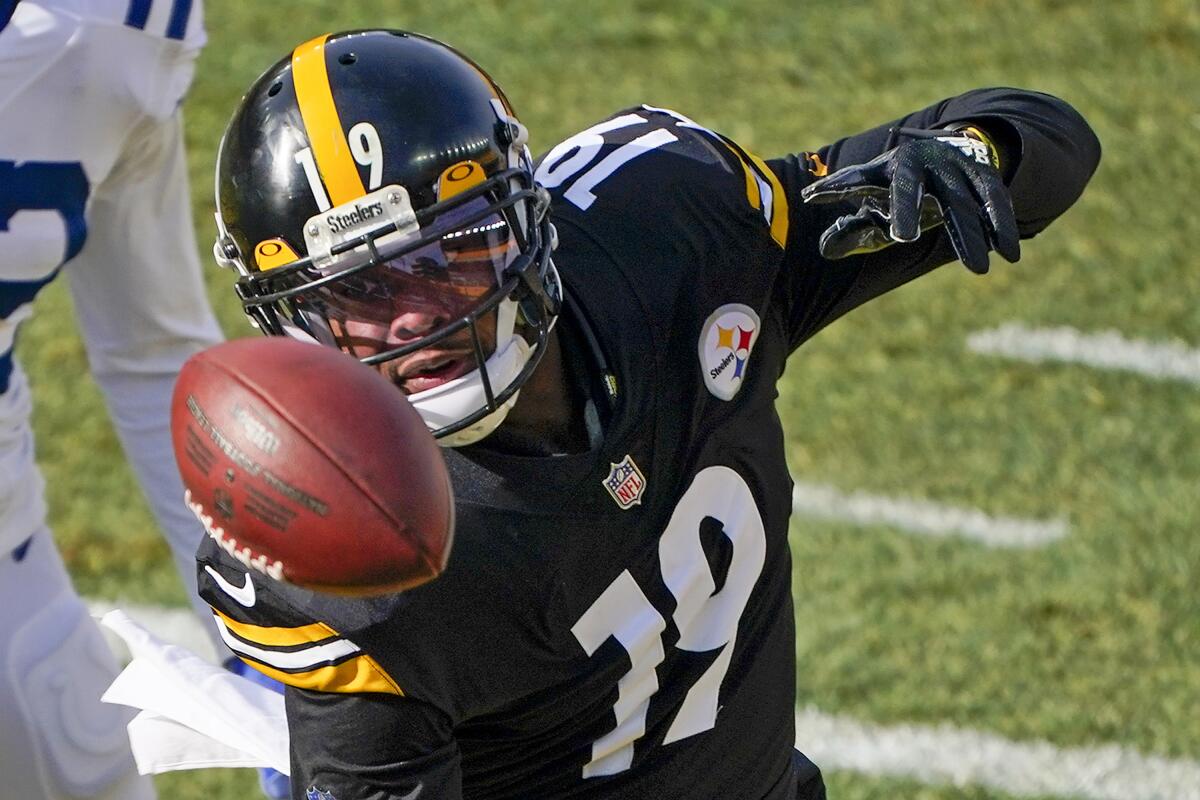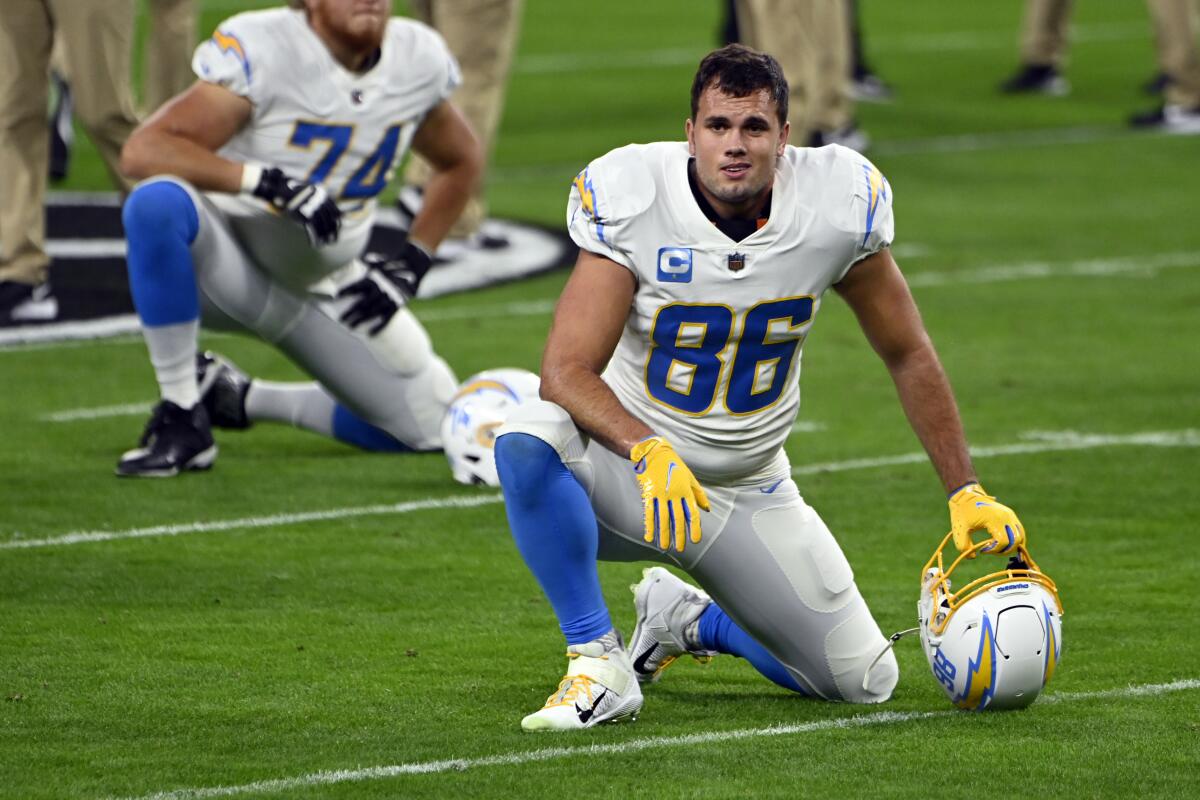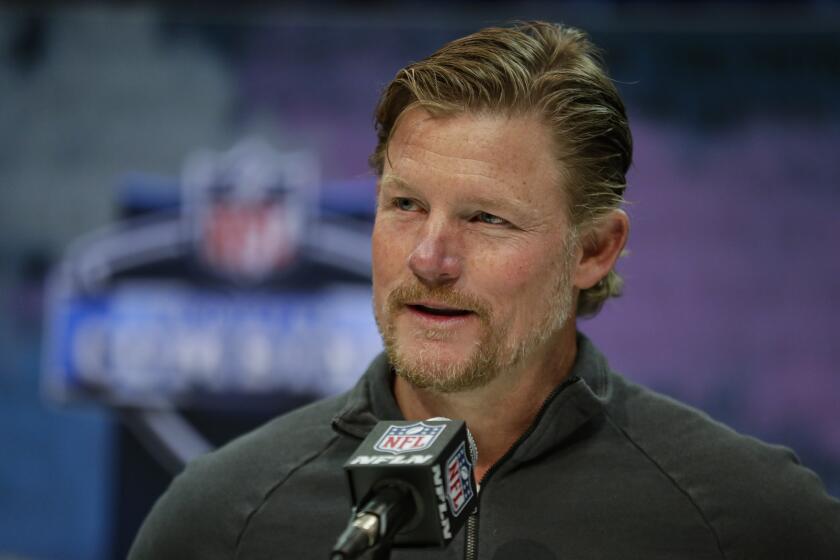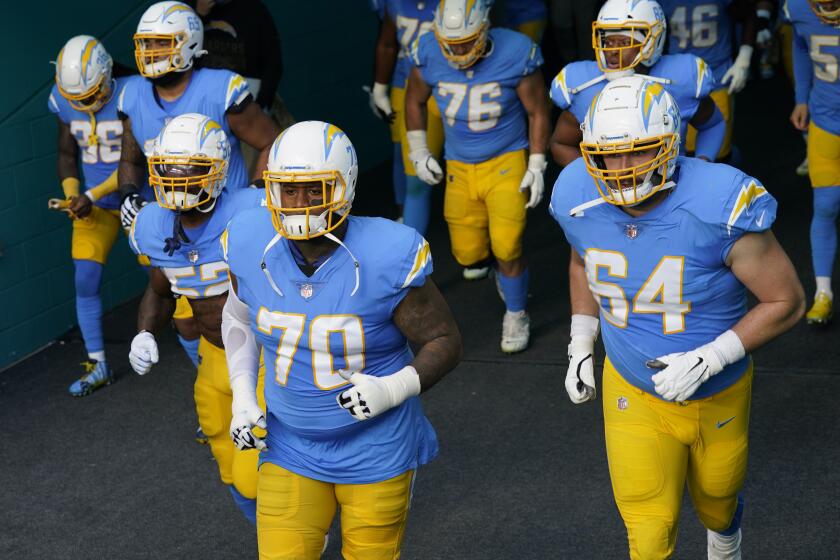What you need to know about NFL free agency and the reduced salary cap

- Share via
Cut, cut, hike!
The NFL’s 2021 business year begins Wednesday, and the marketplace will be filled with high-profile free agents as teams have to shed costs in the wake of a bizarre season of fake crowd noise and cardboard fans.
Whereas a year ago everyone was focused on where Tom Brady would land, this year is more about droves of sub-superstars who nonetheless could make a big difference for teams. The legal tampering period begins Monday, meaning teams and players can start lining up deals.
Tampa Bay pass rusher Shaq Barrett figures to hit the open market, as do Green Bay running back Aaron Jones, Detroit receiver Kenny Golladay, Pittsburgh receiver JuJu Smith-Schuster, Chargers tight end Hunter Henry and San Francisco tackle Trent Williams.
Some questions and answers for what’s to come:
The salary cap is set at $182.5 million. Why is that significant?
Although that’s still gobs of money to cover player salaries — more than was allotted three years ago — it’s a significant step down from last year’s $198.2 million. It’s only the second time since the cap was put in place in 1994 that the number has gone down from the previous year. The only other time was in 2011, in the wake of the lockout, when it was essentially stagnant.
Rams GM Les Snead hopes to contend with how far over the salary cap the team is by restructuring contracts of veteran players so cuts don’t have to happen.
So what does it mean when the cap goes down?
A lot of teams have to do some serious belt-tightening to get in compliance, so players who might otherwise be signed or re-signed are flushed into the free-agent marketplace. So the pool of available talent is unusually deep.
Was this expected?
Yes and no. Everybody knew the cap was going to go down this year in light of how much revenue the NFL lost because of the pandemic. A season without spectators comes at a price. But salary-cap planning is done years in advance. Players are signed to multiyear deals, not multimonth deals, and no one could have predicted a season without fans. When they were drawing up these deals before the pandemic, teams were anticipating a 2021 salary cap of closer to $210 million, and a nearly $30-million swing is gigantic.
With all those good players available, what now?

This is where it gets really interesting. Like most years, the bad teams are the ones with the most money to spend, and, generally speaking, are most willing to part with players and reboot. The teams with the most available money are the Jacksonville Jaguars, New York Jets and New England Patriots, who were 7-9 in their first season after Brady. So some really good free agents could be faced with a decision: Do I sign a more lucrative, longer-term deal with a bad team, or take a financial haircut to sign a one-year deal with a good team, having a better chance of winning a ring before re-setting my value for next season?
Does this situation favor the bold teams?
It could. Most teams are reluctant to make dramatic changes, and when coaches have players who know their system, their instinct is to focus on continuity. Yet say you have a guard, a good player who’s due to make $11 million this year. All of a sudden, you see the marketplace flooded with good offensive linemen. More passive teams might say, “We’ve got our guy and we’re happy with him. We might as well stay put.” But a team that’s less risk-averse might say, “We can replace this guy, if only for a year or two, at say $7 million for next year. Then we can push forward the difference and leave ourselves in better cap position for 2022.”
What’s the upside of a one-year deal for a player?
If a player settles for less than he thinks he’s worth, he can re-enter the market in 2022, when theoretically talent is more scarce and available money is more abundant. He could play well enough this season to improve his value. Then again, he’ll have one more year of wear and tear on his body.
If good players are available on the cheap, why don’t teams just cobble together a roster filled with guys on one-year deals?

When it comes to those short-term fixes, a little goes a long way. There are 22 starters, so if you swap out two players that’s almost 10% of your starting lineup. A club that relies too much on those Band-Aids takes on a much greater risk of negatively affecting the culture and continuity of the team, and increases the likelihood of mental mistakes with so much roster turnover.
How quickly will panic set in among free agents if they aren’t snapped up right away?
Think of musical chairs, suddenly with more participants and fewer chairs. After the first wave of signings, we could see some quality players signing below-market deals with teams they might not consider in a typical year.
Will next year’s cap bounce back in a big way?
That’s the bet, but there’s no guarantee. No one can say for sure what games will look like. Fans will be back, but in anything close to pre-pandemic numbers?
Chargers release guard Trai Turner after one season in a move that will save the team $11.5 million against the salary cap.
With less money available, what does that mean for draft picks?
The tighter the cap is, the more valuable draft picks are. The easiest way to get quality players on the cheap is through the draft. So in the coming days and weeks we might see an increase of trades that involve draft picks. Some of those might seem as if the team trading a quality player doesn’t get quite as much in draft capital as you would expect.
Are draft picks more of a risk this year?
They could be. This was a bizarre and incomplete college football season. No combine. Zoom interviews. NFL teams don’t have a complete picture of the prospects, at least not as complete as in a normal year.
More to Read
Go beyond the scoreboard
Get the latest on L.A.'s teams in the daily Sports Report newsletter.
You may occasionally receive promotional content from the Los Angeles Times.













